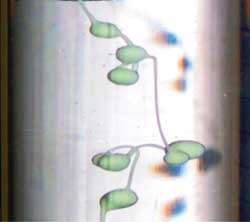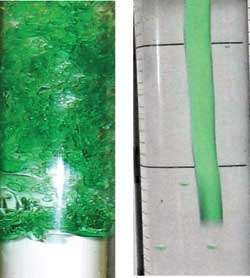Plugging a spewing oil well with cornstarch

A substance more like quicksand and less like ketchup could improve the "top kill" method of plugging a blown-out oil well.
New research by Laboratory scientists in collaboration with a Washington University researcher suggests that a new "mud recipe" using materials such as cornstarch to create a more viscous formula for plugging up a spewing oil well might just work in the future.
In May 2010, BP started a top-kill procedure, in which it would pump heavy mud down the wellbore in an attempt to stop the oil flow coming out of the Macondo well in the Gulf of Mexico. It would take three months before the oil spill was stopped in July by capping the gushing oil head.
The new top-kill method involves overcoming a form of turbulence, which physicists call the Kelvin-Helmholtz instability. This instability can occur whenever two fluids move past one another at different speeds. For example, when wind blows over water, the instability manifests itself in the form of waves on the surface of the water. If the wind is strong enough the waves then break up into tiny water droplets, which are blown away by the wind. The instability also occurs when a heavier liquid like drilling mud is poured into a lighter liquid like crude oil. The trick is to create a liquid that resists the instability by becoming thicker and even hard like a solid under stress, but otherwise flows like a thin fluid.

The Lab's Peter Beiersdorfer, Edward Magee, and David Layne along with Washington University's Jonathan Katz created such a liquid, dubbed shear-thickening by physicists, by using ordinary cornstarch. A shear-thickening liquid like the cornstarch mixture can easily be poured out of its container, but it thickens when shaken. Cornstarch mixed with water acts like quicksand. If you sink in quicksand, it is important to move slowly. The faster you move, the more the quicksand, or in this case the cornstarch mixture, resists your movement. Fast motion, like turbulence, is suppressed by the cornstarch.
In the case of the BP top-kill method, the drilling mud that is made up of a slurry mixture of clay and other minerals broke up into small droplets when mixed with the upstream of the oil, thus not plugging the well, Beiersdorfer said.
The top-kill method is much like ketchup -- a shear-thinning fluid -- which first resists flow and begins to flow quickly only when it is stressed by shaking or by squeezing the bottle.
The researchers conducted a series of experiments at LLNL in which they injected the cornstarch mixture into a five-foot cylinder of oil at speeds comparable to those of the Macondo well to see if it would resist breaking up into droplets.
Beiersdorfer, Magee, and Layne normally work on experiments that explain the radiation from the sun. "Our laboratory is equipped to carry out new ideas on a short notice," Beiersdorfer said. "This was the right thing to do given the nation's needs."
The results, published in the Jan. 31 issue of Physical Review Letters, show that the cornstarch formula descended down the oil column without breaking up. Adding a shear-thickening agent like cornstarch may work as a top-kill procedure to plug up a gushing oil well in the future.
"For a denser fluid (mud) to descend through an upwelling vertical column of lighter fluid (oil), it must not break up into packets or droplets with a settling velocity less than the upwelling velocity," he said.
The project was funded by the Laboratory Directed Research and Development Program.
"These experiments provide a new tool in energy exploration and well control in the future," Beiersdorfer said. "Hopefully, if such a disaster occurs next time, the response will be greatly improved."
Provided by Lawrence Livermore National Laboratory



















